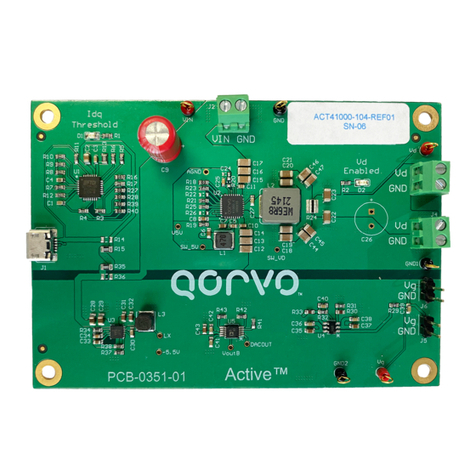Introduction
This document provides a guideline for the execution of the FCC radio certification tests of Zigbee / Matter™/
Bluetooth Low Energy modules using QPG6105 chips. This document focusses on Bluetooth Low Energy
mode certification for the FCC regulatory domain.
At start of the radio certification test the applicable PHY (BLE) can be selected in the Radio Control Console
software [1].
This document is based on, and aligned with, the technical requirements given in CFR 47 PART 15, Section
15.247 “Operation within the bands 902 - 928 MHz, 2400 - 2483.5 MHz, and 5725 - 5850 MHz”.
Table of Contents
Introduction...................................................................................................................................................... 1
1Device under Test (DUT)......................................................................................................................... 2
2
Block Diagrams and Functional Description............................................................................................ 3
2.1 General Description.......................................................................................................................... 3
2.2 Power Regulation............................................................................................................................. 3
2.3 Frequency Synthesis and Modulation.............................................................................................. 3
2.4 RF Interface...................................................................................................................................... 3
3
Radio Information .................................................................................................................................... 4
3.1 Applicable Standard......................................................................................................................... 4
3.2 Duty Cycle Correction Spurious Emission According Section 15.35(c)........................................... 4
3.3 Bluetooth Low Energy Duty Cycle Correction Factor....................................................................... 5
3.3.1
Application limited ....................................................................................................................... 5
3.3.2
TX Frequency Domain Duty Cycle / Spreading.......................................................................... 5
3.3.3
Summary FCC Duty Cycle Correction ........................................................................................ 5
3.4 Measurement of Radiated Emissions at the Band Edge ................................................................. 5
3.5 Bluetooth Low Energy Frequency Range ........................................................................................ 5
3.6 Frequency Generation Scheme ....................................................................................................... 5
3.6.1
TX mode...................................................................................................................................... 5
3.6.2
RX mode ..................................................................................................................................... 5
3.7 Radio Frequency Radiation Exposure Evaluation ........................................................................... 6
4
Operating Manual.................................................................................................................................... 7
4.1 System Setup................................................................................................................................... 7
4.2 Quick Start Guide for Terminal Emulator ....................................................................................... 10
5
RF Testing ............................................................................................................................................. 11
5.1 Select the PHY Mode..................................................................................................................... 11
5.2 Select RF Port/Antenna ................................................................................................................. 11
5.3 Set-Up Procedure for TX Modes.................................................................................................... 11
5.3.1
Configure Board Support Package ........................................................................................... 11
5.3.2
Select Output Power Level........................................................................................................ 11
5.3.3
Select RF Channel.................................................................................................................... 11
5.3.4
Select BLE Data Rate............................................................................................................... 11
5.3.5
Turn TX on, (Un-)modulated CW.............................................................................................. 12
5.4 Transmit Packets............................................................................................................................ 12
5.4.1
BLE Test Packet ....................................................................................................................... 12
5.4.2
BLE Packet Length ................................................................................................................... 12
5.4.3
Transmit Packets ...................................................................................................................... 12
5.5 Set-up Procedure for RX Mode...................................................................................................... 13
5.5.1
Select RF Channel.................................................................................................................... 13
5.5.2
Turn RX On............................................................................................................................... 13
5.5.3
Print Packets Sent/Received in BLE Mode............................................................................... 13
References .................................................................................................................................................... 14
Abbreviations................................................................................................................................................. 14
Important Notice ............................................................................................................................................ 15
Document History .......................................................................................................................................... 15




























